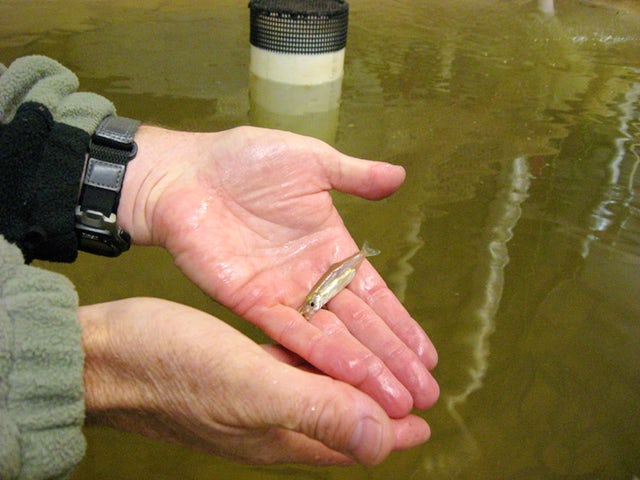
Deeply Talks: Protecting Native Fish in the Delta

by Ian Evans
6-1-2018
In this episode of Deeply Talks, Tara Lohan, Water Deeply’s managing editor, speaks with University of California, Davis fisheries experts Peter Moyle and John Durand about the challenges and opportunities for fish restoration in the California Delta.
The Delta is a critical artery for California’s water. The estuary is the outlet for two of the state’s most important rivers – the Sacramento and San Joaquin – and it is a main source of the water transported south through the Central Valley Project and the State Water Project.
It is also a “completely human-dominated system,” said Moyle. The Delta has been dramatically altered by levees, farms and other human impacts. All those changes have made its native fish, like the Delta smelt and Chinook salmon, vulnerable to the impacts of climate change, pollution, water demand and invasive species. Moyle, Durand and their colleague Carson Jeffres recently wrote a report, titled “Making the Delta a Better Place for Native Fishes,” which addresses the challenges that native Delta fish face and how managers can improve their chances of survival.
One of the biggest hurdles is that, in some ways, the Delta has changed so dramatically that invading clams and weeds fit into the ecosystem better than native fish, said Moyle. Still, “The native fishes are our heritage,” he said, and some species, like Chinook salmon, are economically important.
One of the easier ways to improve the lives of these fish, they say, is to re-open or improve floodplains along the Delta. Floodplains, according to Durand, are perfect for this kind of restoration.
“They dry out, so you can control the species that are using those habitats,” he said. “Clams can’t live in a place that drys out. Brazilian water weeds can’t invade in a place that drys out. And yet, when it floods up … it becomes habitat for not only salmon, but other native fishes that are rare and valued.”
Other issues, like sewage, pollution and pesticides that flow into the Delta, will be harder to solve. Real restoration throughout the Delta will be difficult and long. But by not letting the perfect be the enemy of the good, say Moyle and Durand, managers can prevent native species from disappearing altogether.
That kind of compromise might include accepting the controversial WaterFix, also known as the Delta Tunnels. Neither Durand nor Moyle say that they are strong supporters of the tunnels, but Moyle says “my opinion is, they’re an option.”
“The Delta is this sort of ad hoc system that’s been built upon iteratively,” said Durand. “Anything that we can implement on a large scale to give us more flexibility in terms of how we manage it – for Delta stakeholders, for the environment, for native fishes – would be a good thing.”
To learn more about fisheries in the Delta, listen to the entire Deeply Talks episode. For advance notice of upcoming Deeply Talks and upcoming News Deeply events, subscribe to our weekly newsletter.
In fact, they’re the only option right now, says Moyle, that takes the Delta’s future needs and challenges, like sea level rise, into account. Durand agrees. The problems in the Delta are so complex that a tool like the tunnels could be helpful.
This article originally appeared on Water Deeply. You can find the original here. For important news about water issues and the American West, you can sign up to the Water email list.
Ian Evans is the community editor for environment at News Deeply. Before joining News Deeply, he was a freelance science journalist in Boston with a focus on environmental law and policy. He has been published in Undark Magazine, FiveThirtyEight, Nautilus and more. Ian grew up in California, and before getting into journalism he planned on becoming an ecologist. Instead, he pursued science writing and in 2016 he earned an MS in science journalism from Boston University. When he has spare time, Ian likes to get out and go hiking, backpacking and birding.
Website Hosting and Design provided by TECK.net